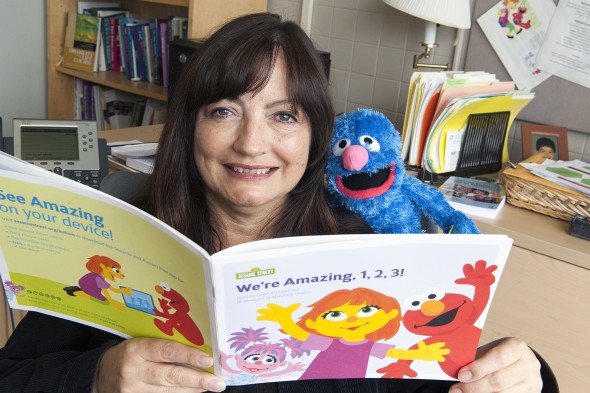On Sesame Street: teaching Grover and Elmo about autism

Sandy Magaña, professor of disability and human development, was asked to be an adviser to “Sesame Street and Autism” because of her work with Latino families. Photo: Roberta Dupuis-Devlin
Sandy Magaña recently saw three years of her work contribute to a worldwide resource in the hands of Elmo, Grover and Abby.
Sesame Workshop, the production company behind “Sesame Street,” launched “Sesame Street and Autism: See Amazing in All Children” in late October. The site offers online narratives to help families create daily learning moments for children with autism, and to teach others about autism. Most of the pieces are designed to be shared with children.
Magaña, professor of disability and human development in the UIC College of Applied Health Sciences, was one of 11 advisers to the initiative.
“I was asked to participate because of my research with Latino families, since Sesame Street appeals to diverse audiences,” Magaña said.
“One of my studies right now is an education program for Spanish-speaking parents after a diagnosis, about what autism is and how it’s manifested in their children. We teach advocacy skills and evidence-based strategies that they can use at home. We train parents to be the educators for other families.”
Her input began with an exploratory meeting with Sesame Workshops in May 2012 in New Jersey. Advisers included clinical and academic experts in autism.
Before the meeting, Magaña asked a gathering of Spanish-speaking parents of children with autism what they’d want on the site. She found they had the same concerns as other families: for other children to understand autism, to help protect their children from bullying.
Project includes videos, storybooks, iPad app
Sesame Workshop sent the advisers drafts for feedback as the project continued.
The resulting site offers “daily routine” flash cards that show Big Bird, Elmo and other Muppets doing everyday activities like getting dressed, crossing the street and going to a store.
Animated and live-action videos show how individual children with autism behave, and how their families relate to them. One segment features three Latina sisters, the youngest of whom has autism.
A storybook introduces Julia, a new character with autism who spends the day with Elmo and Abby, enjoying the same things although she sometimes behaves differently.
Additional readings tell how to be a caretaker, friend or sibling to children with autism. Users are encouraged to share their own stories on social media with the hashtag #SeeAmazing. An iPad app is also available.
“It’ll be interesting to see how effective they are,” Magaña said of the project. “They’re not trying to do intervention, but there are interventions that use this sort of story model to prepare kids in advance of doing something that may be stressful for them.”
Six days after the site went live, Sesame Workshops reported 1.35 billion impressions for its multimedia efforts, with responses from about 35 countries.
Another important enhancement is still to come, Magaña said.
“I asked them to put this information in Spanish,” she said. “They said that’s a priority and they’re fundraising for it.”
